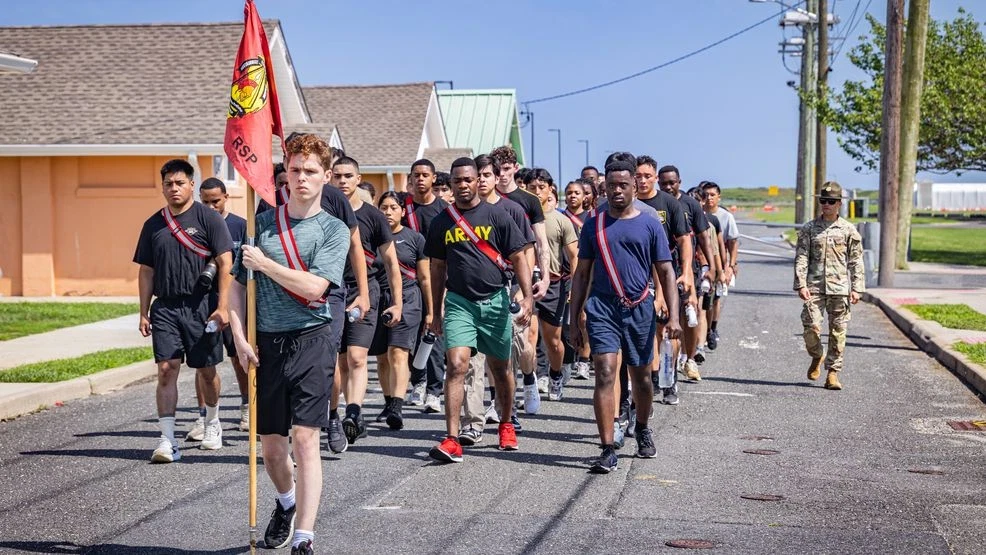
For the first time in four years, all branches of the U.S. military have hit their recruiting goals.
The fiscal year ended this week, with the of future sailors since the early 2000s.
“Most importantly, every new Sailor we welcome strengthens our Navy for the challenges ahead,” Rear Adm. James Waters, the leader of the Navy Recruiting Command, said in a military release.
The Navy recruited over 44,000 sailors in fiscal year 2025.
The recruiting successes marked a stark turnaround from the of the past few years.
Meanwhile, the Army was sitting at 111% of its recruiting goal as of August, according to the that have been released.
With 11 months of fiscal year 2025 reported, the Navy was at 108% of its goal, and both the Air Force and Marine Corps were at 100% of their goals.
The Navy fell short in the previous fiscal year, though it met its contracting goals. The Navy just wasn’t able to ship all recruits due to basic training limitations, according to a Department of War release from the time.
The then-Department of Defense called 2023 the toughest recruitment year for the military services since the inception of the all-volunteer force, which began 50 years earlier.
In fiscal year 2023, none of the Army, Navy or Air Force hit their recruitment goals.
And in fiscal year 2022, the Army only hit about three-quarters of its recruitment goal.
War Secretary Pete Hegseth earlier this year called it a “recruiting renaissance.”
“When our standards are high, when the mission is clear, when we prioritize warfighting over wokeness, that energizes the young men and women of our country, the very patriots over this American experiment we have always needed,” at the Army War College in late April.
So, what’s driving the turnaround?
Waters, the head of the Navy Recruiting Command, credited targeted advertising campaigns, innovations and policy changes.
He said the Navy addressed administrative frustrations in the recruiting process, according to the .
He cited a streamlined tattoo approval process for recruits as an example.
Courtney Manning, who has researched military recruitment and readiness with the , credited both an increased visibility of the military and wider job trends with boosting recruiting and retention.
She noted that the climbed significantly over the past year, from about 1.27 million a year ago to 1.3 million as of the end of August.
Manning said uncertainty in the federal hiring environment outside of the War Department is likely keeping more troops from separating, given that around a quarter of the federal workforce outside the military is comprised of veterans.
And a outside of the government could be making military service more appealing for young people, though Manning said there’s only anecdotal evidence for that impact at this point.
“I hope it does, because I would like to see our best and brightest defend our nation,” Manning said.
But the remains small for the military.
The Army Recruiting Command says over 70% of youth don’t qualify for military service because of obesity, drugs, physical and mental health problems, misconduct or aptitude.
The Recruiting Command says half of youth admit they know little to nothing about military service.
Nearly 80% of recruits have a relative who served, but only 1% of the population currently serves.
Manning has published research on how .
Hegseth addressed military fitness this week while in Quantico, Virginia.
“I’m also directing that warfighters in combat jobs execute their service fitness test at a gender-neutral age-normed male standard scored above 70%,” Hegseth said. “It all starts with physical fitness and appearance. If the secretary of war can do regular hard (physical training), so can every member of our joint force. Frankly, it’s tiring to look out at combat formations, or really any formation, and see fat troops. Likewise, it’s completely unacceptable to see fat generals and admirals in the halls of the Pentagon and leading commands around the country and the world. It’s a bad look. It is bad, and it’s not who we are.”
Manning said the Navy and Army had introduced policies that made it easier for overweight people to get in and stay in service.
She said new guidance that was this week appeared to offer more leeway based on the commander’s discretion for fitness standards than Hegseth’s messaging would suggest.
Hegseth used the word “woke” five times in his speech to the generals this week.
Manning downplayed the impact of the change in administration or change in political ideology as drivers in the recruiting surge.
Those changes will appeal to some new recruits and not others, she said.
Manning said research indicates that the changes might reduce the overall number of women and people of color in service.
But she said “lifestyle constraints,” such as income and socioeconomic background, matter far more than political ideology when it comes to choosing military service.
“The vast majority, regardless of what political party they’re in, are seeking a better life for themselves, learning new skills that they think they can apply to future positions, and doing something with their lives that they feel is meaningful or personally beneficial … . And that’s pretty much the same across both political parties,” Manning said. “I wouldn’t expect people who see the military as their best option to change those parameters based on a political ideology, because the majority of them, put quite bluntly, don’t have that luxury.”
She pointed to a showing that pay and benefits remain the leading reason for joining the military.
Almost 30% of youth said in the survey that finding a full-time job in their community was difficult to impossible.
Worries over physical or mental injury remained the leading reasons for not joining.
Over 90% of recruits are between the ages of 17 and 21, Manning said.
“While some young people are quite ideological, others have not given it too much thought and are not having the kinds of analytical debates that … a lot of people are currently having in the higher levels of the Department of Defense about that,” she said.
Manning said military recruiting and retention have seen “an incredible rise,” but she said we’re not out of the woods yet.
“Given the rapid expansion of threats in the geopolitical environment and the expanded priorities of the current administration, the estimated need for combatants and support positions across several commands, across the world, are probably greater than our current supply, even given the good increases in recruitment and retention,” Manning said.



